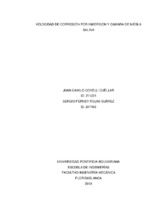| dc.contributor.advisor | Director. Santos Jaimes, Alfonso | |
| dc.contributor.author | Covelli Cuéllar, Juan Camilo | |
| dc.contributor.author | Rojas Suárez, Sergio Ferney | |
| dc.coverage.temporal | 2018 | |
| dc.date.accessioned | 2020-05-20T16:59:57Z | |
| dc.date.available | 2020-05-20T16:59:57Z | |
| dc.date.issued | 2018 | |
| dc.identifier.uri | http://hdl.handle.net/20.500.11912/5428 | |
| dc.description | 69p.: (pdf); il; imágenes; gráficas; tablas; anexos. | spa |
| dc.description.abstract | Con el avance de la humanidad y en paralelo con las exigencias que esto conlleva, cada dra se exige mas a la industria para que logre estar a la altura de dichos requerimientos. Es relevante el conocimiento que se tenga respecto a Ia corrosion, en especial los mecanismos que puedan mitigar dicho proceso permitiendo, ademas, disminuir las perdidas econ6micas generadas por esta. Para Ia ejecuci6n del proyecto se emple6 un estudio experimental en un acero comiin: SAE 1020, sabiendo que la corrosion influye directamente a este material, se aplicaron diversos recubrimientos tales como el carburo de tungsteno, la alOmina, y el di6xido de titanio. Estos, se adhirieron a las placas metalicas que estaban siendo material de investigaci6n por un proceso Ilamado rociado termico; lo anterior, con el fin de mejorar las propiedades ffsicas y mecanicas del acero. Como objeto principal del proyecto, se determin6 la velocidad de corrosion tanto en las laminas que contaron con los recubrimientos anteriormente mencionados, como aquellas a las que no fueron expuestas a algiin proceso para mejorar sus propiedades. Para lograr medir la velocidad cuantitativamente, se recurri6 a dos procesos que simularon una alta corrosion en las piezas, inicialmente con pruebas de inmersion de las laminas en acid° clorhfdrico con una concentraci6n del 30% por un tiempo total de 240 horas; seguidamente, se realiz6 el analisis mediante camara de niebla salina por un tiempo maxim° de 168 horas, con el fin de comparar de manera cuantitativa Lcual de los materiales arrojaba un valor menor a las piezas sin proceso de recubrimiento?. Como principal resultado, se puede nombrar el exit° obtenido en Ia simulaci6n del proceso de corrosion en las piezas que fueron expuestas a los ensayos despues de someter de manera ffsica la superficie de las piezas basadas en las normas ASTM G-31 Y B-117. | spa |
| dc.description.abstract | The progress of the humankind entails new demands. Every day the industry sector requires new developments to achieve these demands. It is required every day more to the industry in order that it manages to be at a height of sayings, Especially the mechanisms that could mitigate the above-mentioned process allowing, also, to diminish the economic losses generated for is. For develop the project an experimental study was used in a common steel: SAE1020, knowing that the corrosion influences directly to this material, there were applied such diverse coverings as the carbide of tungsten, alumina, and dioxide of titanium. These, Adherer to the metallic plates that were a material of investigation for a so called dewy thermal process; the previous thing, to improve the physical and mechanical properties of the steel. As principal object of the project, the speed of corrosion decided so much in the sheets that possessed the coverings previously mentioned, as those to which they were not exposed to any process to improve his properties. To manage to measure the speed quantitatively, One resorted to two processes that simulated a high corrosion in the pieces, Initially with tests of dip of the sheets in hydrochloric acid with a concentration of 30% in a total time of 240hours; Immediately afterwards, The analysis was realized by means of chamber of saline fog by a maximum time of 168hours, In order to compare in a quantitative way Which of the materials was throwing a minor value to the pieces without process of covering?. As principal result, it is possible to name the success obtained in the simulation of the process of corrosion in the pieces that were exposed to the tests after submitting in a physical way the surface of the pieces based on the procedure ASTM G-31 and B-117. | eng |
| dc.format.mimetype | application/pdf | |
| dc.language.iso | spa | |
| dc.publisher | Universidad Pontificia Bolivariana | spa |
| dc.rights | Attribution-NonCommercial-NoDerivatives 4.0 International | * |
| dc.rights.uri | http://creativecommons.org/licenses/by-nc-nd/4.0/ | * |
| dc.subject | Corrosión y anticorrosivos | spa |
| dc.subject | Velocidad | spa |
| dc.subject | Normas técnicas - ASTM G-31 | spa |
| dc.subject | Normas técnicas - ASTM b - 117 | spa |
| dc.subject | Cámara de niebla | spa |
| dc.title | Velocidad de corrosión por inmersión y cámara de niebla salina | spa |
| dc.type | Trabajo de grado | spa |
| dc.publisher.department | Escuela de Ingenierías | spa |
| dc.publisher.program | Ingeniería Mecánica | spa |
| dc.type.hasVersion | publishedVersion | spa |
| dc.description.sectional | Bucaramanga | spa |
| dc.description.degreename | Ingeniero Mecánico | spa |


